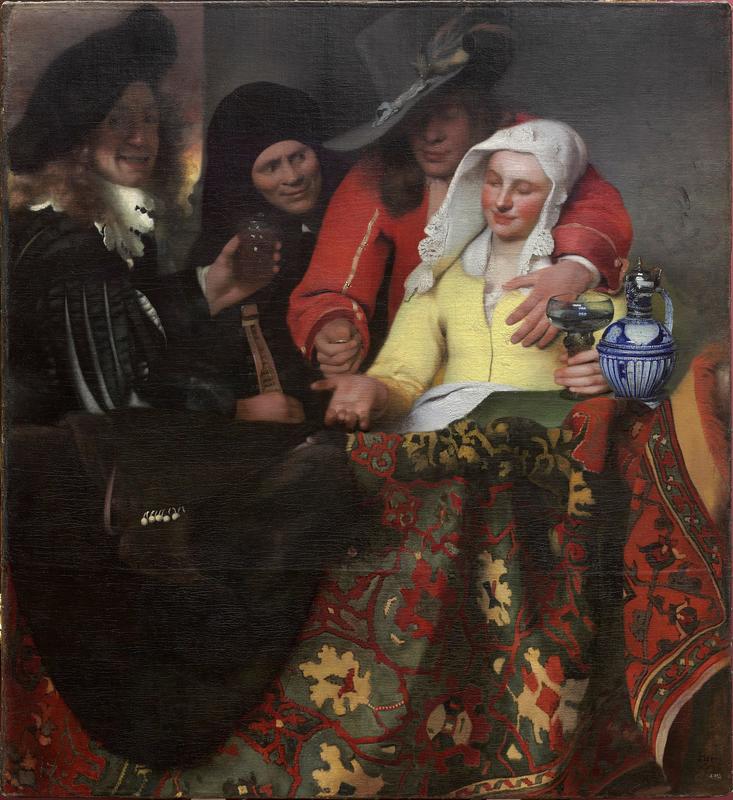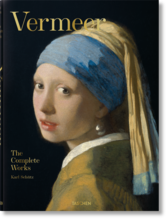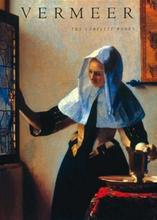More about The Procuress
- All
- Info
- Shop

Contributor
Vermeer Pays Cash to Cop a Feel
If you know a bit about Vermeer, then you know it wasn’t customary for him to paint dudes groping brothel babes. Sure, she's got more clothes on than Édouard Manet's famous hooker Olympia, but there's clearly an illicit transation going down. Afterall a "procuress" (or hilariously, "koppelaarster" in German) is a woman who supplies prostitutes. This painting was in fact considered a fake for quite a while because it was so naughty – historians were sure it was by the forger extraordinaire, Hans van Meegeren. But very recently Science, the mother of fact, said: make no mistake, it’s no fake, it’s a Vermeer!
A number of theories have been proposed to answer the much-asked question: Why did the mostly subdued artist decide to paint such a raunchy picture? Some say this was his earlier work so he was, on various levels, fondling his way through his feelings on art.
Others say that such scenes were a hot topic for artists of that time period. Vermeer’s mom-in-law supposedly had a version of Dick van Baburen’s Procuress hanging in the household. Her Baburen version was in the background of some of Vermeer’s own paintings, and he might’ve liked it enough to make a copy of his own. The Baburen version definitely stars a louder, lustier wench but Vermeer, being the strong silent type, made his more understated.
To further prove it's a Vermeer, he stars in the painting himself as the musician! The groper handing a coin and handling the woman's goodies, is Vermeer's wife's brother Willem. But who did Johannes use as inspiration for the free-wheeling prostitute? Why, his wife, naturally! Way to place yourself in the action, buddy. Another theory is that Vermeer’s daughter, Maria, is the artist, but why you would paint your dad copping a feel is beyond us.
Featured Content
Here is what Wikipedia says about The Procuress (Vermeer)
The Procuress (Dutch: De koppelaarster) is a 1656 oil-on-canvas painting by the then 24-year-old Johannes Vermeer. It can be seen in the Gemäldegalerie Alte Meister in Dresden. It is his first genre painting and shows a scene of contemporary life, an image of mercenary love perhaps in a brothel. It differs from his earlier biblical and mythological scenes. It is one of only three paintings Vermeer signed and dated (the other two are The Astronomer and The Geographer). In 1696 the painting, being sold on an auction in Amsterdam, was named "A merry company in a room".
The woman in black, the leering coupler, "in a nun's costume", could be the eponymous procuress, while the man to her right, "wearing a black beret and a doublet with slashed sleeves", has been identified as a self portrait of the artist; there is a resemblance with the painter in Vermeer's The Art of Painting.
It seems Vermeer was influenced by earlier works on the same subject by Gerard ter Borch, and The Procuress (c. 1622) by Dirck van Baburen, which was owned by Vermeer's mother-in-law Maria Thins and hung in her home. Some critics thought the painting is atypical of Vermeer's style and expression, because it lacks the typical light. Pieter Swillens wrote in 1950 that—if the work was by Vermeer at all—it showed the artist "seeking and groping" to find a suitable mode of expression. Eduard Trautscholdt wrote 10 years before that "The temperament of the 24-year-old Vermeer fully emerges for the first time".
The jug on the oriental rug is a piece of Westerwald Pottery. The kelim thrown over a bannister, probably produced in Uşak, covers a third of the painting and shows medallions and leaves. The instrument is probably a cittern. The dark coat with five buttons was added by Vermeer in a later stage. The man in the red jacket, a soldier, is fondling the young woman's breast and dropping a coin into her outstretched hand.
According to Benjamin Binstock, this "dark and gloomy" painting could be understood as a psychological portrait of his adopted family and does not represent a didactic message. Binstock says Vermeer used his family as models; the procuress could be Vermeer's wife Catherina and the lewd soldier her brother Willem.

Check out the full Wikipedia article about The Procuress (Vermeer)

















